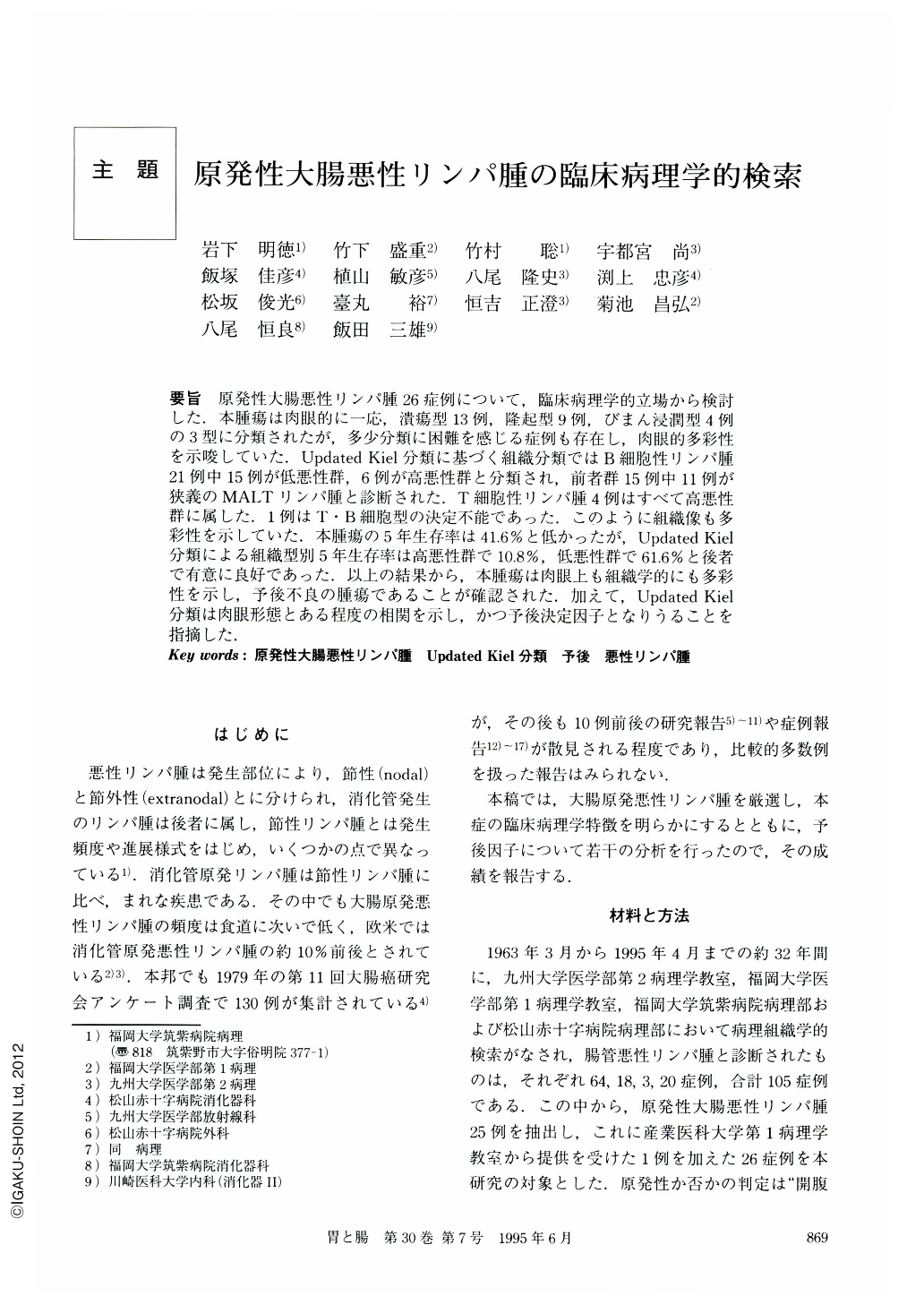Japanese
English
- 有料閲覧
- Abstract 文献概要
- 1ページ目 Look Inside
- サイト内被引用 Cited by
要旨 原発性大腸悪性リンパ腫26症例について,臨床病理学的立場から検討した.本腫瘍は肉眼的に一応,潰瘍型13例,隆起型9例,びまん浸潤型4例の3型に分類されたが,多少分類に困難を感じる症例も存在し,肉眼的多彩性を示唆していた。Updated Kiel分類に基づく組織分類ではB細胞性リンパ腫21例中15例が低悪性群,6例が高悪性群と分類され,前者群15例中11例が狭義のMALTリンパ腫と診断された.T細胞性リンパ腫4例はすべて高悪性群に属した.1例はT・B細胞型の決定不能であった.このように組織像も多彩性を示していた.本腫瘍の5年生存率は41.6%と低かったが,Updated Kiel分類による組織型別5年生存率は高悪性群で10.8%,低悪性群で61.6%と後者で有意に良好であった.以上の結果から,本腫瘍は肉眼上も組織学的にも多彩性を示し,予後不良の腫瘍であることが確認された.加えて,Updated Kiel分類は肉眼形態とある程度の相関を示し,かつ予後決定因子となりうることを指摘した.
Clinicopathological study of primary malignant lymphoma of the large intestine was carried out in 26 specimens obtained from 24 cases resected surgically and two cases autopsied. The results obtained were as follows:
(1) Malignant lymphoma of the large intestine comprised 23.8% of all malignant lymphomas of the gut. Twenty-four of those 26 tumors were advanced malignant lymphomas. The remaining two tumors were early malignant lymphomas. The average age was 63.8 years and male to femade ratio was 1.36: 1. Malignant lymphoma of the large intestine was most frequently observed in the ileocecum (seven of 26 cases) and in the rectum (seven of 26 cases).
(2) According to Watanabe's classification, the tumors studied were macroscopically classified with some difficulty into three groups, as follows; ulcerative type (13 cases), polypoid type (nine cases) and diffusely infiltrating type (four cases). The cut surface of the lymphoma was homogenously gray-white, elastic soft in consistency and clearly demarcated. Here was only one lesion in each 25 cases, but, in the other case, there were three lesions.
(3) According to LSG classification, all tumors were histologically diffuse type, and the cell types of the tumor cells were classified into six groups as follows; medium-sized cell type (11 cases), mixed type (five cases), large cell type (four cases), pleomorphic type (three cases), Burkitt's type (two cases), and small cell type (one case).
(4) Immunohistochemical staining was positive for L-26, which is the most sensitive marker of B-cells, in tumor cells of 21 cases (namely B-lineage), and was positive for UCLH-1, which is marker of T-cells, in tumor cells of four cases (namely T-lineage), and was positive for both L-26 and UCLH-1 in the tumor cells of one case (namely the undetermined case).
(5) According to Updated Kiel classification, fifteen out of the 21 lymphomas of B-lineage were low-grade malignant lymphomas such as centrocyte-like type (nine cases), centroblastic-centrocytic type (four cases), lymphoplasmacytic/-cytoid type (one case) and monocytoid type (one case). The remaining six cases were high-grade malignant lymphomas such as centroblastic type (four cases) and Burkitt's lymphoma (two cases). Eleven of the 15 low-grade malignant lymphomas of B-lineage were classified also as MALT lymphomas. All four cases of T-lineage were high-grade malignant lymphomas such as pleomorphic mediumsized and large cell (three cases) and angiocentric type (rare type, one case). A lymphoepithelial lesion was found in only three cases, all of which were MALT lymphoma.
(6) Relationship between macroscopic types and location of the lymphoma revealed that the ileocecal lymphomas were more frequently of the ulcerative type (71.4%) and lymphomas of other sites were distributed almost equally between ulcerative and polypoid type.
(7) Comparison between histologic types and location of the lymphoma showed that lymphomas of the rectum rather than of the ileocecum and transverse colon were frequently low-grade malignant lymphoma (71.4%).
(8) Relationship between histologic types and macroscopic types disclosed that according to LSG classification, the more the tumor cells increased in size, the more the lymphoma was likely to be of the ulcerative type and, according to the Updated Kiel classification, the incidence of ulcerative type was higher among high-grade malignant lymphomas rather than among low-grade malignant lymphomas.
(9) The overall five-year survival rate was 41.6%, but, considering the cases in the light of the Updated Kiel classification, it was noted that there was only a 10.8% five-year survival rate for cases with high-grade malignant lymphoma, while there was a 61.6% five-year survival rate for cases with low-grade malignant lymphoma. The difference between the low-grade malignant lymphoma group and the high-grade malignant lymphoma group was statistically significant. The tumor size and whether the lesion is MALT-lymphoma or not, as well as the histologic type based on the Updated Kiel classification were prognostic factors, the macroscopic type and distinction between T or B-lineage, were not prognostic factors.
In conclusion, it was shown that primary malignant lymphoma of the large intestine has many variegated macroscopic and microscopic features and an unfavorable postoperative prognosis. It was also shown that histologic type according to the Updated Kiel classification is an important prognostic factor as it is also in nodal malignant lymphoma.

Copyright © 1995, Igaku-Shoin Ltd. All rights reserved.


